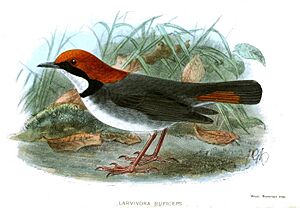Rufous-headed robin facts for kids
Quick facts for kids Rufous-headed robin |
|
|---|---|
 |
|
| Conservation status | |
| Scientific classification | |
| Genus: |
Larvivora
|
| Species: |
ruficeps
|
| Synonyms | |
|
Luscinia ruficeps |
|
The rufous-headed robin (Larvivora ruficeps) is a small songbird. It belongs to the Muscicapidae family, which includes robins and flycatchers. This special bird lives only in central China.
It prefers to live in cool forests and bushy areas. Sadly, this robin is not well known and is endangered. Its biggest problem is losing its natural home.
Contents
About the Rufous-Headed Robin
What's in a Name?
Scientists group living things into categories. The rufous-headed robin was once in a group called Luscinia. But in 2010, scientists studied its DNA. They found it fit better into a different group, Larvivora. So, it moved to its current genus.
This robin is closely related to the rufous-tailed robin (Larvivora sibilans). It is also related to the Japanese robin and the Ryukyu robin.
What Does It Look Like?
The rufous-headed robin is a small bird, about 15 centimeters (6 inches) long. It has a bright orange-red head. Its face is black, and its throat is white with a black border.
The back, upper chest, and sides of its body are grey. Most of its belly and lower parts are white. Its tail is black with reddish-brown edges. The tips of its outer tail feathers are dark. This robin has a strong and clear song, similar to the Ryukyu robin.
Where Does It Live?
Its Home in China
This robin has only been seen in a few places. These are mainly in the Qin Mountains of Sichuan and southern Shaanxi in China. It has also been spotted a few times during its migration.
Scientists believe there are not many of these birds left. Their total number might be between 1,500 and 3,800 birds.
Preferred Habitat
The rufous-headed robin lives in forests that have both conifer (like pine trees) and deciduous (trees that lose leaves) trees. It also likes bushy areas. It lives at high altitudes, between 2,400 and 2,800 meters (about 7,900 to 9,200 feet) above sea level. It seems to like new bushy areas that grow after floods in valleys.
Scientists use computer models to find other places where this robin might live. They predict suitable homes in parts of Sichuan, Gansu, Shaanxi, and Tibet.
Protecting the Rufous-Headed Robin
Why It's Endangered
The number of rufous-headed robins seems to be going down. The IUCN (International Union for Conservation of Nature) first listed it as Vulnerable until 2012. Then, in 2013, it was changed to Endangered. This change happened because people rarely see the bird now. This suggests its population is still shrinking.
The main reasons it is in danger are:
- Habitat loss: Its forest and scrubland homes are disappearing or getting damaged.
- Being caught: Sometimes, these birds are caught by people.
Scientists and conservationists are working to protect this rare and beautiful bird.


